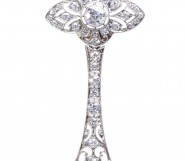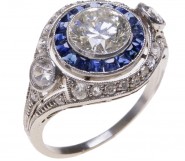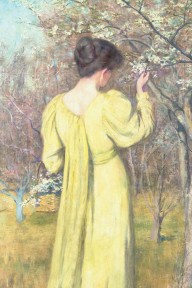Lot #46 - Frederick McCubbin
-
Auction House:Mossgreen
-
Sale Name:Fine Australian Art
-
Sale Date:28 Oct 2014 ~ 6.30pm
-
Lot #:46
-
Lot Description:Frederick McCubbin
(1855-1917)
Mrs McCubbin Picking Blossom (Spring) 1890
oil on canvas
137 x 80 cm
signed and dated 'F. McCubbin 1890' lower right -
Provenance:Deutscher Fine Art, Colonial and Impressionist Paintings, July 1982 cat. no. 18, illustrated on front cover; Private Collection Melbourne; Private Collection, Sydney
-
Exhibited:The Art of Frederick McCubbin, National Gallery of Victoria, 1991-1992
-
References:Andrew MacKenzie, Frederick McCubbin 1855-1917, 'The Proff' and his art, Magnum Press 1990; Bridget Whitelaw, The Art of Frederick McCubbin, National Gallery of Victoria, 1991, pp. 52-53, pl. no. 16
-
Notes:This large narrative, poetic, lyrical and tender work is one of the last major Frederick McCubbin 'gems' still held in private hands. Catalogued as Spring (Mrs McCubbin Picking Blossom), 1890 by Bridget Whitelaw in The Art of Frederick McCubbin Exhibition Catalogue, National Gallery of Victoria, 1991, Plate 16, pp. 52-3, the work depicts Annie McCubbin picking blossom, most probably in the old orchard surrounding their Rathmines Road, Hawthorn residence. Mrs McCubbin Picking Blossom was painted at one of the happiest times of Frederick McCubbin's life, a time when both his career and personal life were blossoming, and the work is very much a reflection of this happiness. However, this happiness was soon to change with the loss of his daughter, Mary on 30 October 1894, only days away from her third birthday. It was a time when Frederick McCubbin produced a number of his major 'nationalistic' narrative works, nostalgic works capturing the history of the pioneers, such as Down on His Luck, 1889 and A Bush Burial, 1890. This was also a time that the works of Frederick McCubbin began showing the strong influence of the Barbizon plein air painters, Jean-Franois Millet (1814-1875) and Jean-Baptiste Camille Corot (1796-1875) and of the naturalistic landscapes of Jules Bastien-Lepage (1848-1884). Knowledge of the works of these artists, McCubbin gained from books and Art journals and from his artist colleagues such as Tom Roberts, who had visited Paris in 1884-85, Julian Ashton, who had studied in Paris around 1874 and Walter Withers who had studied in Paris in 1887-88. Not only busy working on large 'nationalistic' landscapes, Frederick McCubbin was also active working as Instructor and Master of the School of Design, National Gallery of Victoria, a position he had been appointed to on 7 June 1888. Further recognition came in 1891 when he was appointed Director of the National Gallery, a position he held until Mr Lindsay Bernard Hall took over as Director in March 1892. Happiness was found in his personal life with his marriage to Ann (Annie Lucie) Moriarty, known as Annie, at St. Ignatius Church, Richmond on 5 March 1889. Frederick McCubbin was born on 25 February 1855 and Annie on 25 August 1865. During 1884, Frederick had been introduced to Annie at an Artists' Picnic at Blackburn and Annie was known to have visited Frederick McCubbin and his artist colleagues at the Box Hill Artists' Camp during 1886 and 1887. It was here at the Box Hill Artists' Camp that Annie posed for Tom Roberts for his work, Reconciliation, c.1887 (Castlemaine Art Gallery and Historical Museum). The year following their marriage, their first child Louis, was born on 18 March 1890 at 86 Rathmines Road, Hawthorn or Auburn, as it was sometimes known. Louis was named after Louis Abrahams and both Louis Abrahams and Walter Withers named their sons, Frederick after Frederick McCubbin. Annie gave birth to two further children at this Rathmines Road address, Mary their first daughter on 4 November 1891 and Alexander who was born on 3 April 1893, shortly before the family moved to Lot 52, Wolseley Crescent, Blackburn. In The Art of Frederick McCubbin, Melbourne, Lothian Book Publishing, 1916, James MacDonald notes page 61, 'It was the hey-day of these stirring times that Frederick McCubbin married and settled down at Auburn. Auburn is memorable for the life class he instituted there. One afternoon a week he hired a model, and in the large studio which he had built at the back of the house all his friends would gather regularly to paint and draw from life.' The Rathmines Road address was also therefore a happy place where fellow artists gathered. As it was surrounded by an old orchard, it is likely that it was here that Annie posed for this work, with McCubbin completing the painting in what has been described as his Òlarge studioÓ. Half a year after the birth of Louis, Mrs McCubbin Picking Blossom, depicts 25 year old Annie in the Spring of 1890, in a dress which her daughter Kathleen informed me was probably made by Annie, 'for she was an excellent seamstress'. (see entry, Frederick McCubbin 1855-1917: 'The Proff' and his art, Andrew Mackenzie Mannagum Press, 1990, Plate 15, p. 68-9.). Annie's pose is one which follows a well established convention of Victorian narrative painting and the depiction of women within a poetic landscape, symbolizing various seasons, which was adopted by many English, French and Australian artists at that time. Bridget Whitelaw in The Art of Frederick McCubbin, 1991, p. 52, draws attention to two earlier works, Autumn c.1882 and Spring, 1882 painted by George Frederick Folingsby, Master of the School of Art, and Frederick McCubbin's instructor at the National Gallery of Victoria between 1882 and 1886. Whitelaw notes that, 'Following the success of Spring, 1882 by George Folingsby, which depicts an elaborately costumed girl stretching to pick a blossom, many local artists had completed paintings on the same theme. The Letter, 1884 is one of McCubbin's earliest versions of the woman in the landscape.' Autumn and its companion painting, Spring were familiar to many through the medium of photogravure. 'ÒSpringÓ was given the most prominent position at the Victorian Academy of Arts exhibition in 1883 and reproduced as an engraving for the Art Union of Victoria that year.' (Table Talk, 20 March 1891, p. 7). Frederick McCubbin would have been very aware of Folingsby's works, and also those of Charles Conder and Arthur Streeton who in the period 1888 to 1890 produced a number of works depicting Spring, with blossoms and women within orchards, and these may well have inspired and influenced Frederick McCubbin. Both Streeton and Conder were pupils of Frederick McCubbin in the Drawing School of the National Gallery of Victoria, with Arthur Streeton enrolled from 1886 to 1888 and Charles Conder enrolled in 1889. In the Spring of 1888, Charles Conder travelled from New South Wales and joined Frederick McCubbin, Tom Roberts and a number of fellow artists at the Box Hill Artists' Camp. Conder also took part with Arthur Streeton, Tom Roberts, Frederick McCubbin and three others in the 9 x 5 Impression Exhibition which opened on 17 August 1889, and in which Conder exhibited amongst his works, No. 141, Herrick's Blossoms. (NGA Collection). Herrick's Blossoms was but one of a number of blossom works that Conder produced at this time, others being, The Farm, Richmond, New South Wales, 1888 (NGV Collection), Springtime, 1888 (NGV Collection) and A taste for literature, 1888 (Ballarat Fine Art Gallery Collection). All of these works depict women in a landscape with fruit trees in blossom, and Conder continued with this theme when he arrived at Box Hill, painting, Orchard at Box Hill, 1888 (NGV Collection). Arthur Streeton at this time produced works such as his poetic, lyrical work, Butterflies and Blossoms, 1889 (NGV Collection) and also Eaglemont, 1889 (Ballarat Fine Art Gallery Collection), depicting a woman in the orchard on the Mount Eagle estate. The alternative title to this work is Autumn and was said to be inspired by lines such as 'To bend with apples the mossed cottage-trees. And to fill all fruit to ripeness to the core'-from the poem To Autumn by John Keats. Streeton also produced his large pastoral landscape, Spring, 1890 (NGV Collection), depicting children bathing in a very swollen Yarra River and cattle grazing on the rich river flats, now part of Banksia Park, Heidelberg. Walter Withers also produced a work which he titled, Spring in 1902. In this work Withers depicted his eldest daughter, Gladys and several young lambs frolicking in a field of Spring grasses. Coincidently, or possibly not, like McCubbin in his work, Mrs McCubbin Picking Blossom, 1890, Withers produced Spring soon after the birth of his son, Charles, born on 5 February 1902. Like McCubbin with the birth of his son, Louis in 1890, this was a very happy time for the Withers family, especially since Withers first son, Frederick had died in 1892, after living only five weeks. Frederick McCubbin's depiction of his wife, Annie in Mrs McCubbin Picking Blossom was only one of many canvases in which he included women as a central focus, and Annie from this time on, was very much his favourite model. As well as modeling for Mrs McCubbin Picking Blossom, 1890, Annie also modeled for A Bush Burial, 1890 (Geelong Art Gallery Collection); Portrait of Mrs McCubbin, 1892 (NGV Collection): Feeding Time, 1893; Maternity, 1894 (whereabouts unknown); On the Wallaby Track, 1896 (AGNSW Collection); A Ti-Tree Glade, 1897 (AGSA Collection); Autumn Memories, 1899 (NGV Collection); Portrait of Mrs McCubbin (a study in grey), 1900 (NGV Collection); in the first two panels of the triptych, The Pioneer, 1904 (NGV Collection), Portrait of Annie McCubbin (from Motherhood, c.1904-later painted out); Mrs F. McCubbin (Wearing a Black Plumed Hat), 1911 (NGV Collection), and Shelling Peas, 1912 (NGV Collection). The mood created by Frederick McCubbin in Mrs McCubbin Picking Blossom, 1890 is however in sharp contrast to the solemn mood captured by the overcast sky, grey-green foliage and dull browns in his works, Down on his Luck, 1889 and A Bush Burial, 1890. In A Bush Burial, 1890, Annie is dressed in black, with her head bowed and McCubbin has created for us a narrative scene of pathos and sentiment. While in Mrs McCubbin Picking Blossom, 1890, Annie is depicted with her head raised as she picks the blossom, wearing a full length dress, the colour of which is full of life and energy. Although this work shows the influence of the Barbizon artists, Annie's upright pose and style and colour of gown is certainly not that of the women working in the fields, as depicted by many of the Barbizon artists, or of the women working in the Australian landscape later depicted by Clara Southern in her works such as An Old Bee Farm, c.1900 (NGV Collection) and A Country Washhouse, c.1905. In Mrs McCubbin Picking Blossom, 1890, Frederick McCubbin has captured the essence of Spring, with the blossom symbolizing the beginning of new life and of abundance. McCubbin has painted Annie with a new palette, a softer, delicate, more intimate palette, with Annie very much at one with the landscape. Annie interacts with the landscape as she actively gathers the fruit blossom in a small wicker basket. The hem of Annie's dress merges with the grass as if fusing the model to the landscape and this was a technique which Frederick McCubbin used in many of his works. Frederick McCubbin had earlier captured this interaction with the landscape in his narrative Box Hill Artists' Camp works, Gathering Mistletoe, 1886 and Lost, 1886 (NGV Collection), where in Gathering Mistletoe, 1886, the young girl has successfully gathered mistletoe and in Lost, 1886, the young girl, although apparently lost, has not let go of the mistletoe she has gathered. Feeding Time, 1893, in which Annie is depicted feeding the family's chickens is another work in which Annie is actively interacting with the landscape and is another work heavily influenced by the Barbizon traditions. Also in contrast to Mrs McCubbin Picking Blossom, 1890, Frederick McCubbin depicts Annie in a much different light in his works, Autumn Memories, 1899, where Annie is depicted as contemplative and seems to have little interaction with her surroundings, or in the very formal, posed studio work of a reserved and not very cheerful Annie in full ball gown and gloves, with an added bush background, in Portrait of Mrs F. McCubbin (a study in grey), 1900. On a personal level, Mrs McCubbin Picking Blossom would have been a work of great significance to Frederick McCubbin. He would have felt great love for the subject and for the model and given the number of works for which Annie later modeled for Frederick, Annie showed that throughout their married life she was very supportive of his work. Their love for one another continued through the years and years later, on 7 August 1907, when Frederick McCubbin wrote to Annie from France, while on his trip to London, he ended his letter with, 'My Darling. God Bless you all, and kisses for Louis and Alex and Syd and Hugh, Sheila and Baby, Your devoted lover and sweetheart, Fred. McCubbin.' On 13 October 1990, a hundred years after Mrs McCubbin Picking Blossom, 1890 was painted, a review of my book, Frederick McCubbin 1855-1917: 'The Proff' and his art, written by John Lahey was published on the front page and page 6 of the Saturday Extra of The Age, under the title, The Lost McCubbins. Mrs McCubbin Picking Blossom, 1890 was one of the works illustrated in colour and one of the works which at that time was 'Lost', in that its whereabouts was unknown to me. Within days of the review appearing, I was delighted to receive a phone call from the Melbourne owner, informing me that this Frederick McCubbin 'gem' was held within his collection and was a family favourite. Andrew Mackenzie OAM
-
Estimate:A$1,200,000 - 1,600,000
-
Realised Price:
-
Category:Art
This Sale has been held and this item is no longer available. Details are provided for information purposes only.













